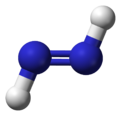- Diazene
-
Diazene 


 DiazeneOther namesDiimide
DiazeneOther namesDiimide
DiimineIdentifiers CAS number 3618-05-1  , 15626-43-4 (E)-diazene
, 15626-43-4 (E)-diazene  , 15626-42-3 (Z)-diazene
, 15626-42-3 (Z)-diazene 
PubChem 123195 ChemSpider 10612167 
KEGG C05360 
MeSH Diazene ChEBI CHEBI:30096 
Jmol-3D images Image 1 - N=N
Properties Molecular formula H2N2 Molar mass 30.03 g mol−1 Exact mass 30.021798074 g mol-1 Appearance Yellow gas Melting point -80 °C, 193 K, -112 °F
 (verify) (what is:
(verify) (what is:  /
/ ?)
?)
Except where noted otherwise, data are given for materials in their standard state (at 25 °C, 100 kPa)Infobox references Diazene, also called diimine or diimide, is a compound having the formula (NH)2. It exists as two geometric isomers, E and Z. Diazene is also the parent member of the entire class of azo compounds with the formula (NR)2, where R is an organyl group. Thus, azobenzene is an example of an organic diazene.
Contents
Synthesis
The traditional route to diimide involves oxidation of hydrazine with hydrogen peroxide or air.[1] Alternatively the decarboxylation of azodicarboxylic acid affords diimide:[2]
- (NCO2H)2 → (NH)2 + 2 CO2
Diazene can also be efficiently generated by elimination of sulfonohydrazides using a suitable base. For example 2,4,6-triisopropylbenzenesulfonohydrazide eliminates diazene upon treatment with sodium bicarbonate, a very mild base.
Because of its instability, diimide is generated and used in-situ. A mixture of both the cis (Z-) and trans (E-) isomers is produced, both of which are unstable. The isomerisation can be slow. The trans - cis equilibrium is driven to the right due to the rapid consumption of the cis isomer upon reaction with the unsaturated substrate. Some procedures call for the addition of carboxylic acids, which catalyse the cis-trans isomerization.[3] Diimide decomposes readily via disproportionation:
- 2 (NH)2 → (NH2)2 + N2
Because of this competing decomposition reaction, reductions with diimide typically require a large excess of the precursor reagent.
Applications to organic synthesis
Main article: Reductions with diimidecis-Diazene is occasionally useful as a reagent in organic synthesis.[3] It hydrogenates alkenes and alkynes with selective delivery of hydrogen from one face of the substrate resulting in the same stereoselectivty as metal-catalysed syn addition of H2. The only coproduct released is nitrogen gas. Although the method is cumbersome, the use of diimide avoids the need for high pressures or potentially explosive hydrogen gas and metal catalysts, which can be expensive.[4] The hydrogenation mechanism involves a six-membered C2H2N2 transition state:
Selectivity
Diazene is advantageous because of it selectively reduces alkenes and alkynes and is nonreactive toward many functional groups that would interfere with normal catalytic hydrogenation. Thus, peroxides, alkyl halides, and thiols are tolerated by diimide, but these same groups would typically be degraded by metal catalysts. The reagent preferentially reduces alkynes and unhindered or strained alkenes[1] to the corresponding alkenes and alkanes.[3]
See also
References
- ^ a b Masaji Ohno and Masaru Okamoto (1973), "cis-Cyclododecene", Org. Synth., http://www.orgsyn.org/orgsyn/orgsyn/prepContent.asp?prep=cv5p0281; Coll. Vol. 5: 281
- ^ Wiberg, E.; Holleman, A. F. (2001). "1.2.7: Diimine, N2H2". Inorganic Chemistry. Elsevier. pp. 628. ISSN 0123526515. http://books.google.com/books?id=LxhQPdMRfVIC&pg=PA628&lpg=PA628&ots=Vio7HpXhQD&sig=Xskqzd2PyjI4Z76qhZ95jyS6pWA#PPA628,M1.
- ^ a b c Daniel J. Pasto "Diimide" in Encyclopedia of Reagents for Organic Synthesis, 2001, John Wiley & Sons. doi:10.1002/047084289X.rd235
- ^ Miller, Charles E. "Hydrogenation with Diimide" Journal of Chemical Education 1965, volume 42, 254-9. doi:10.1021/ed042p254
Categories:- Azo compounds
- Nitrogen hydrides
Wikimedia Foundation. 2010.

